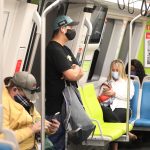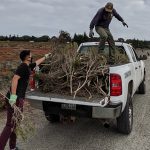Welcome to Monitor Notes, a weekly roundup of news items, event announcements, and updates on past Bay Area Monitor articles.
COVID-19 Commuting

Holiday hubbub is certainly different this year, but what hasn’t changed is taking time to understand the feelings of others. Essential workers, from teachers and health-care professionals to retail employees, are playing a significant role in our capacity to push forward during the pandemic. But their ability to safely get to work hasn’t been easy given transportation service cuts. Nonprofit Seamless Bay Area is helping explain essential workers’ experiences during a noon webinar today. It’ll be joined by a group of UC Berkeley planning and engineering graduate students who interviewed workers this fall to hear what it’s like navigating the region’s transportation network. Their project, which examined commutes to San Francisco, Oakland, and Palo Alto, found that concerns about physical distancing, transit frequency, and public safety are common.
Off the Charts

BayREN, an Association of Bay Area Governments (ABAG) project, recently introduced the “Bay Area Energy Atlas.” It’s a large database to help local governments with their climate goals by showing how their communities use energy. The atlas, developed in partnership with UCLA’s California Center for Sustainable Communities, links PG&E energy consumption data to building characteristics, socio-demographic data, and other factors. That’s all incorporated into an interactive map with annual consumption stats (including natural gas) that you can view based on building type, size, or year, in addition to residential income. Watch the October 28 webinar (click here and scroll to the bottom) to learn more about using the tool. Then scan the Sierra Club’s tally of cities phasing out natural gas. Guess which Bay Area city just joined the list?
Growth Planning

Want to learn more about projects that affect how the region grows? Listen to identical webinars with the Metropolitan Transportation Commission and ABAG on December 18 from noon to 1:30 p.m. or January 5 from 9:30 to 11 a.m. Staff will give updates on the final Plan Bay Area (PBA) 2050 blueprint and a presentation on the draft Regional Housing Needs Allocation (RHNA) methodology. Read material about the PBA 2050 final blueprint and draft RHNA methodology ahead of the meetings. Or, prep with the Monitor for a glimpse into the PBA planning process.
Learn Your Drought Lesson

The California Data Collaborative (CaDC), a network of water professionals, is hosting a noon webinar on December 17 that taps into research about how household water use responded to and rebounded from the 2012-2016 drought. The event is led by Stanford University’s Jose Bolorinos (pictured here), a Ph.D. candidate in civil and environmental engineering who’s specializing in urban water and energy supply infrastructure. It marks the first installment of CaDC’s winter webinar series featuring influential professionals in the water sector. Register here to learn about the benefits of drought conservation practices.
Volunteer Motivation

Monitor Notes often highlights volunteer opportunities. And while Notes didn’t give a heads up about a California State Parks’ invasive plants project, the group’s recent blog offers a chance to break the ice about nurturing our open spaces. Foundation Core Leader Matthew Todd wrote about a fall ice plant removal project at Ford Ord Dunes State Park, which edges up to Monterey Bay. It turns out the ice plant is particularly “insidious” along coastal dunes and overwhelms native plants, Todd said. Volunteers repurposed large pieces of ice plant to block illegal social trails that emerge in fenced-off areas when people trample on sensitive habitats. You can read about the effort here. Where would you like to have an impact?
Monitor Notes is produced by Cecily O’Connor. To receive it by email, scroll to the bottom of this page, enter your email address in the box under “RECEIVE EMAIL UPDATES,” and click the red “SIGN UP” button.